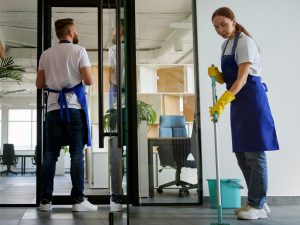Handymen often have a wide range of skills that allow them to tackle almost any project. They can fix leaky faucets, hang curtains, install shelves, and much more.
This handyman has a clean website that clearly lists their services and features an easy-to-use quote request form. They also instill trust with their customer reviews and certifications. Click Here to learn more.

Handymen have a wide range of home maintenance skills, making them an ideal choice for handling a to-do list of small repairs and renovations. However, if your plumbing repairs require more advanced or complex work, it may be best to seek the services of a licensed professional plumber.
A plumbing contractor can repair and install various faucet fixtures, pipes, toilets, showers, garbage disposals, and dishwashers. They can also unclog drains and repair water leaks, ensuring that your plumbing system works properly and efficiently.
Most states require licensed professionals to perform certain plumbing tasks, including installing or repairing gas lines and toilets. Unlike handymen, contractors often have years of experience and a strong understanding of the latest industry standards. As such, they can provide more thorough and comprehensive services than a handyman.
While some handymen specialize in or originate from a specific trade, most are jacks of all trades. This makes them able to offer an extensive set of maintenance services that do not require licensing or inspection. For instance, most handymen can paint, assemble furniture, and clean gutters. However, they may not be able to replace your roof or repair your foundation.
The main difference between a handyman and a general contractor is that a general contractor requires a license to do most construction-related jobs, while a handyman does not. A general contractor often oversees a team of subcontractors to complete large projects that may take months to finish and cost thousands of dollars. A handyman, on the other hand, usually only works with one or two helpers and is responsible for the overall project management.
If you hire a handyman to handle your maintenance needs, make sure to clear the workspace and remove any personal belongings that might obstruct their work zone. It is also important to remain present during the process and ask any questions you might have. This way, you can make sure that your expectations are aligned with the professional’s capabilities.
A handyman’s broad skill set and time-saving convenience makes them an excellent choice for tackling a to-do list of minor repair projects. However, if you need specialized services like major plumbing leaks or extensive electrical work, you should use a licensed professional.
Electrical
A handyman should be well-versed in electrical wiring and able to repair a variety of issues. This includes checking for loose wires, faulty outlets and switches, and identifying any circuits that are overtaxed or have been damaged. He should also be able to run cables between rooms for televisions and other electronic devices.
Installing lights is another common electrical job that a handyman can handle. However, it’s important that these lights are properly grounded and wired according to local laws and regulations. This ensures that the handyman isn’t creating dangerous conditions or posing a fire hazard.
You’ve likely heard horror stories about people who hired a handyman to do electrical work only to find that corners were cut and the job was done poorly. The results of this can range from an insurance company refusing to pay a claim to blown fuses or even house fires.
If your handyman isn’t licensed to perform electrical work, he should agree in writing that if anything goes wrong with the work, he’ll return and fix it for free. This helps protect you from shoddy work that can cost more in the long run than it’s worth.
It’s also important to hire a handyman with experience handling residential and commercial electrical work. This way, he’ll be familiar with the latest safety protocols and have the knowledge necessary to do a great job.
In addition to installing new light fixtures, your handyman can also handle other home lighting projects, including dimmer switches and landscape lights. These lighting upgrades can add an elegant, warm glow to your home and increase curb appeal. They can also make your home safer by eliminating the need to use extension cords.
If you’re looking for a professional electrician, turn to the experienced handymen at Handyman Connection. Our vetted service professionals, hometown service, and national backing combine for a stress-free and efficient experience. We’ll connect you with the best local electricians in your area for a quality electrical job. To learn more, contact us today!
Painting
A fresh coat of paint can transform a room and breathe new life into your living space. Handymen are skilled in painting both interior and exterior surfaces, elevating your home’s appearance and addressing any minor imperfections that can occur with time. Their painting expertise can also include installation of trim and molding.
Before painting, handymen will prepare surfaces by repairing cracks and holes and sanding any uneven areas. These prep tasks are often included in labor costs but can vary depending on the condition of walls. Moreover, the number of coats required will influence both labor and paint costs. It is recommended that you apply two coats of paint for a smooth and long-lasting finish.
The average cost of a handyman to paint a standard-sized room ranges from $200 to $500, but this price may vary considerably depending on the specifics of your project. It’s important to get a precise assessment tailored to your unique needs from multiple handymen and painting contractors. This will ensure transparency in the estimation process and prevent any surprises down the road.
Another important service offered by handymen is the cleaning and disposal of painting materials, such as brushes, cans, and rags. This step is often included in the overall estimate but should be clarified beforehand to avoid any misunderstandings. Additionally, some professional handymen may offer a discount on their services during off-peak seasons or slow periods.
A high-quality, professional-grade paint job will last longer and protect your home from the elements. However, a paint job requires special tools and techniques to achieve an even, durable finish. Handymen are experts in both interior and exterior painting, ensuring a high-quality result that will stand the test of time.
Another crucial service offered by handymen is gutter cleaning and repair, which is a critical step in protecting your home from water damage. Handymen are trained to inspect and clear gutters, preventing blockages that can lead to expensive repairs. They can also repair gutters and downspouts to ensure that rainwater flows properly away from your home. This prevents the buildup of moisture in your walls and foundation, which can cause mold and mildew.
Flooring
Handymen are the craftsmen behind flooring transformations, repairing or replacing both walls and floors. Whether a creaky chair leg is driving you crazy or your outdated floor is in need of an upgrade, they can lay down new vinyl, wood, or tile for a fresh look that enhances both function and style. Handymen also tackle a variety of carpentry tasks, such as building custom bookshelves and installing crown molding.
Repairing drywall and painting are some of the most common handyman requests. Minor scrapes, dents, or holes caused by furniture or roughhousing kids can ruin a pristine wall, so they are skilled at patching, priming, and repainting walls to make them look brand new.
Restoring a tiled bathroom, shower, or backsplash is another skill that handymen excel at. They are able to replace damaged tiles, lay down new ones, and grout the spaces, leaving them looking brand-new. Handymen are also capable of laying down new carpet, which can be a great way to freshen up a space or add warmth and texture.
When hiring a Handyman, it is important to communicate with them clearly about the work you want to be completed. Discuss terms like timeline, cost, and payment schedule to ensure that expectations are aligned. It is also helpful to be present during the work to ask any questions and provide feedback. Additionally, it is a good idea to review their cancellation and refund policies so that you are protected in case something goes wrong during the project. Ready to hire a qualified, bonded, and insured Handyman? Start the process with Amenify today.








